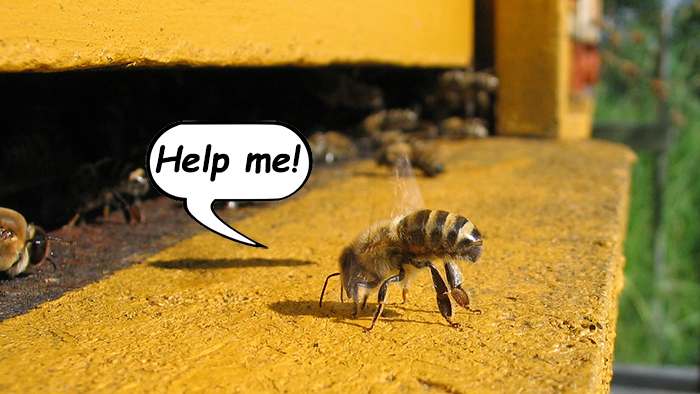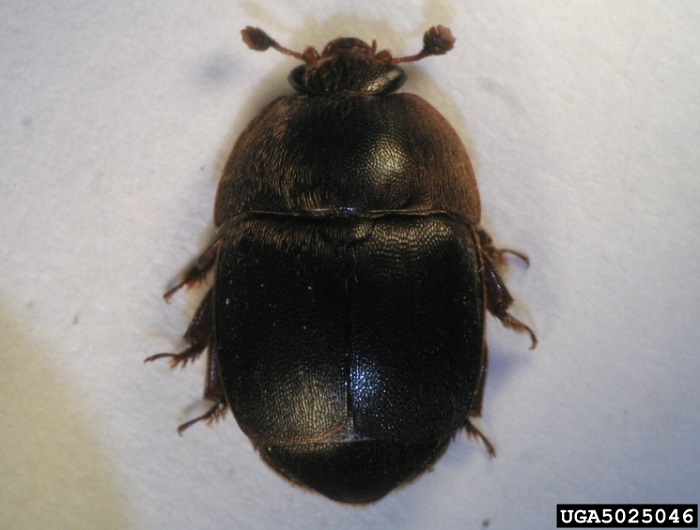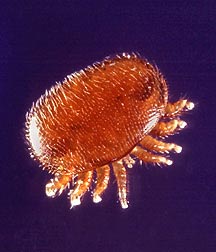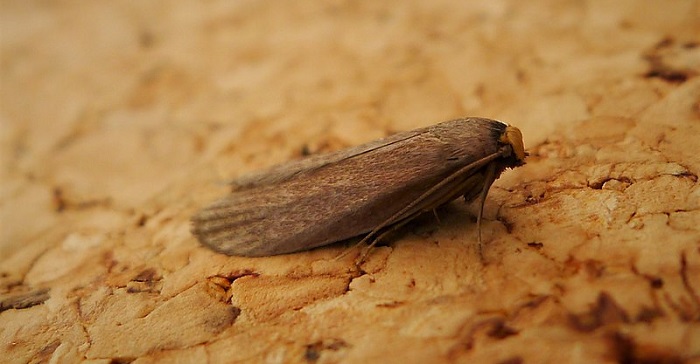
If you took the advice from my last post (Get Started with Beekeeping for under $500) and began a new prepping adventure with beekeeping, or if you are already keeping bees, this post is for you. Nothing is worse than building up your hives only to have them ruined by honeybee pests and problems. So, let me tell you how to fix them.
by Aden Tate, contributing writer and author of The Faithful Prepper
Whether you’re just getting started in beekeeping, or have been doing it for a while, odds are that you’re familiar with the idea that there are things out there that will attempt to destroy your hives. Below is a list of some of the most common honeybee pests and problems that you’ll come into contact with, as well as tips to help ward them off so that your bees stay as healthy as possible.
Small Hive Beetles (SHB)
Other than Japanese beetles, small hive beetles have to be the most annoying beetle on the planet. I can’t stand them. As with most pest species, these are not native to the United States, instead having somehow found their way over here from Africa, where it is a natural pest of African honeybees. African honeybees have ways in which they can actually control the activities of these little boogers within the hive. Our honeybees in America do not, and as a result, our hives can be absolutely devastated by these fast little critters.

These round little black beetles tend to hang out in the brood chamber (though they will infest the entire hive) where they eat honeybee eggs and brood. However, they’ll also eat pollen and honey as well. So really, you have an attack on two fronts from SHBs: less honeybees leads to a weaker hive, and less stored food leads to a hive that’s at an increased risk of starvation throughout the winter months.
And as if that’s not bad enough, if the infestation gets severe enough. SHBs can generate so much heat that the combs will end up collapsing, and your hive may decide its finally time to say adios and search out greener pastures. They’ll poop all over the place as well, causing the honey to end up fermenting and not being much good for eating.
So you’ve got to figure out ways to kill these things. I have some ideas.
Solutions for Small Hive Beetles
There are a number of different options, but I’ll tell you some of the most common.
- Pour a concrete base on the ground where you’re going to place your hives at. Part of the SHB life cycle involves being in the ground right below a beehive. If you don’t have anything to dig into right below the hive, you’ll have a great means of prevention for SHB infestations.
- Oil traps – These are little two-piece plastic traps shaped like a ‘T’. The bottom of the ‘T’ nestles down in between the frames, while the flat top part lays against the tops of the frames. There’s all kinds of holes in the top of the trap. I pour vegetable oil into them so that when the SHBs fall into them, they can’t get back out. You have to replace the traps regularly because they get filled with dead beetles, but this is a decent organic means of pest control.
- Unscented Swiffer pads – If you place one of these flat on top of the frames between supers the bees will get upset and chew it up into a fuzzy little ball. Somehow SHBs that walk across this ball get stuck in it and can’t get themselves back out. I’ll take out the Swiffer pad about two weeks later, and it’ll be filled with dead SHBs, looking like a strange little oatmeal raisin cookie. I’m not sure why the bees don’t get stuck in this, but they don’t. There are commercially available versions of this as well, but they pretty much are exactly the same as Swiffer pads. Just make sure that you get NON-SCENTED pads. Bees don’t like the scented kind.
- There are chemical treatments as well, such as CheckMite+ (which you place in the hive). There is also Gard Star (which you spray the soil with). Overall, I try to avoid these methods if I can. I always try to stay as organic as possible, but when it comes to potentially losing a hive of bees, comb, and honey (all potentially worth $300+), then you do what you have to do.
Varroa Destructor

This is arguably one of the biggest problems facing modern beekeepers (it’s neck-and-neck with CCD, in my opinion). Varroa is a stupid little mite that is originally a pest of the Eastern Honeybee, Apis cerana. Somehow it ended up over here where our honeybees (Apis mellifera) aren’t able to cope with the little pests.
Think of these as very tiny ticks that only attack honeybees (as far as I know; I’ve never heard of them on other creatures). Of course, from the poor little honeybee’s perspective, this is a gigantic tick that likes to suck their blood. Think what it would be like to have a parasite the size of one of your pecs that latched onto you and wouldn’t let go. That’s somewhat similar to the relative size for a honeybee.
Having your life juices sucked out of you is already bad enough, but the true problem with varroa are the viruses that they transmit as a vector or trigger. Like a mosquito with malaria at a beach resort, a varroa mite can bring some foreign disease into the colony’s population. And there’s going to be some viruses already present within the hive before the varroa ever gets there. That’s just life. Viruses are everywhere.
However, the problem is that varroa can also somehow trigger those viruses to make them exponentially worse than what they were before. My personal theory on this is that they diminish the immune system of the honeybees, and a weaker hive poses a greater opportunity for viruses to flourish. Regardless, it’s bad. They can kill your whole hive.
Solutions for Varroa Destructor
So, what can we do?
- Getting a bottom board with metal screening built into the bottom of it will allow varroa to fall out and to the ground when they do occasionally fall within the hive. Without the metal mesh, the varroa mites will just fall onto a piece of wood that forms the bottom of the hive, and crawl back up to latch on another bee. That screened bottom board is an excellent organic form of prevention. From what I understand, the cold air that flows through this in winter months won’t adversely affect the bees either. At least in warmer climates. I have a hard time believing that if you lived in the middle of Maine, a screened bottom board would be kosher with your little chilly honeybees, but for other climates it’s reportedly ok.
- Regularly check for varroa infestations. The way I was taught to do this involves a Mason jar and powdered sugar. I open the hive and scoop up roughly 100 bees (while wearing a bee suit, mind you), and put them into the Mason jar. I then shake powdered sugar on top of the bees while they’re still in the jar. The powdered sugar helps the mites to fall off, and then you can get a rough estimate of how many mites per hundred bees you have in your hive. Alternatively, you can just keep the bees inside the jar until they die, but I don’t like to lose 100 honeybees. Shoot, I don’t like to lose one. I’m attached to the little guys. But it is an option. If you find out you have a heavy infestation, then you’ll know that it’s time to look for harder treatment options.
- There are a large number of chemical treatments out there on the market, including: Apistan, formic acid, CheckMite+, Apilife Var, and Apiguard. The only one that I have personal experience with is FormicPro, and it’s truly some potent stuff. You want to wear full protective gear while you’re handling it, and even the scent is powerful. I’ve irritated the inside of my nostrils after getting just one whiff of the stuff just from opening the package. My bees don’t seem to be as strong after use with this stuff, but at least they’re still there.
Colony Collapse Disorder
This is one of the more mysterious causes of honeybee loss, and as far as I know, nobody’s come to any definite conclusions as to what is the prime mover here. There have been several links that have been shown to be, but nothing that seems to be 100% definite. My personal opinion here is that it’s a conglomeration of these factors that results in a slow but steady chiseling away of the colony’s health. Eventually, there’s a straw that breaks the camel’s back, if you get what I mean.
Solutions for Colony Collapse Disorder
So let’s look at some of the things we can do to prevent CCD.
- Fungi Perfecti has done a number of studies on what can be done to prevent CCD in honeybee colonies, and seems to have shown a very promising degree of success with their research. They’ve found that feeding honeybees a regular supplement of various mushroom mycelium extracts, drastically decreased the rate of CCD in their hives. They’re not a unbiased researcher – they sell mushrooms – but the research still seems promising to me.
- Avoid spraying pesticides on your land whenever possible. There seems to be a link between pesticide use and CCD. Most likely that’s because the honeybees are ingesting the pesticide, or otherwise somehow absorbing it. Either option is not good, and so the less that you spray, the healthier your bees will be.
- Avoid using pre-treated seeds in your garden. If at all possible, avoid buying seed that is covered in that red pesticide. That pesticide is absorbed through the seed, and into the plant, giving the plant a form of immunity from then on out against pests. However, there also seem to be pretty strong links between usage of these types of pesticide treated seeds, and CCD, so avoid these if possible.
- It’s been hypothesized that being located near cell towers can somehow interfere with the bee’s ability to find their way back to the hive, and as a result tamper with the health of the hive as well. This may be another factor to consider when it comes to where you’ll place your hives. I wouldn’t avoid getting a hive started up altogether if I lived near a tower, but I would most certainly do what I could to ensure that my bees were staying as healthy as possible through other means.
Other Bees and Wasps
I suppose the act of theft is even common in the animal kingdom, because even the poor little honeybee has to defend his wealth against thieves. Given the opportunity, both wasps and foreign bees will attempt to make off with some of your honey.

Solutions for Other Bees and Wasps
Fortunately, this is one of the easiest problems to solve.
- First, make sure that there’s only one entrance into the hive. The more entrances that there are into the hive, the more locations that the honeybees have to defend. Just as a castle with four gates is going to be much easier to attack than a castle with one. Honeybees do better when they’re able to focus all of their energy on patrolling just one area.
- Decreasing the size of the entrance can be another way to limit the amount of robbing that takes place for your hives. Pretty much all hives that you buy will have an entrance reducer included in the kit. This entrance reducer is nothing more than a long rectangle of wood that has various sized holes on two sides of it. One side has a large, wide hole, and the other has a small hole. By switching to the small hole, you can help to funnel any attackers to one little area, increasing the chances that your guard bees will run them off.
- Don’t leave sweet and sticky stuff out in the open near your bees either. By that I mean honey, comb, or syrup. If you leave your old frames out in the open, you’re going to attract robber bees to the area, which is just another headache that your poor little honeybees are going to have to deal with. The same goes for syrup. If you’re going to feed your bees a syrup, use an actual feeder. If you put the syrup in a bowl on the ground, you’re going to attract a lot of wasps and other bees to the area that you don’t want to invite.
Wax Moths
Wax moths are typically associated with CCD in that once the hive begins to suffer serious losses, the wax moths seem to make themselves at home more, destroying the hive in the process. The mature moth makes a silken web across the comb as she lays eggs, making a terrible mess. It’s the larva that are the true trouble makers though.
These ugly little grubs tunnel throughout the comb eating brood comb and wax. Left to themselves, they can cause considerable damage to your hive and undo months of your honeybee’s work. You need to eliminate them as soon as possible.

Solution for Wax Moths
The main thing I do for these is just squish ‘em. You can see the moths pretty readily whenever you open the hive. And the grubs make a wonderful hummus (I’m kidding. DO NOT eat the grubs.) If you inspect frame by frame though, you should be able to get most of the grubs out with a nail or paperclip. Then squish them.

The main thing with wax moths is prevention, though. If you store extra supers during the winter, it’s best to store them in a cold environment, where wax moths won’t be able to thrive. Blocking off all access to the extra stored supers, such as through the usage of metal screen mesh on both the top and the bottom of the supers will help to eliminate future wax moth infestations.
Common Honeybee Pests Conclusion
Just like with humans, animals, or any other type of insect, there are a host of health issues that a honeybee can come face to face with. These are just SOME of the pests and problems that honeybees will come into contact with throughout the course of their lives. By following the above advice, however, you should be able to minimize the risk to your hives, so that you can end up enjoying both the work and the rewards of beekeeping for years to come.
